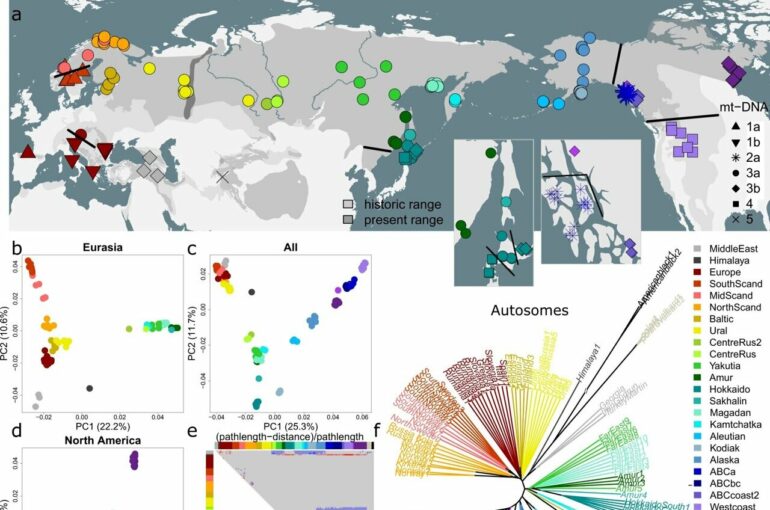Brown bears are among the largest land-dwelling carnivores in the world. They are characterized by a muscular hump over their shoulders, which gives their front legs additional strength. All ten or so brown bear subspecies currently identified are distributed in North America, Europe, Russia, and Asia.
They show great diversity in their shape, habitats, and behavior. In a genomic study published in the Communications Biology, an international team of researchers, including four scientists from Frankfurt am Main, investigated the genetic diversity of brown bears and how and when this variation arose. In doing so, they present the first comprehensive population genomic study of the brown bear (Ursus arctos) and use its example to show the effects of the last ice age on today’s diversity within the species.
The North American grizzly is probably the best-known subspecies—but brown bears are also native to the Eurasian continent, where they live preferentially in (montane) cold forests. Their population is estimated at around 200,000 animals worldwide, of which more than half are assumed to be native to Russia.
Brown bears were common throughout mainland Europe in the Middle Ages; today, just about 17.000 animals live here. Habitat destruction, poaching and lack of acceptance contributed to this decimation. While they are considered extinct in Germany—apart from individual immigrants such as “Bruno” in 2006—they are not classified as endangered worldwide by the International Union for Conservation of Nature and Natural Resources (IUCN).
For the comparison of the brown bear subspecies, the scientists examined the genomes of 128 brown bears from the entire range. 95 of these genomes were decoded especially for this study. The aim was to use new genomic analysis methods to test previous findings on similarities and differences between the various populations and to answer open questions. This also includes which historic factors have led to today’s distribution and the respective genomic characteristics.
“In order to obtain a comprehensive overview of the population structure and genetic diversity of brown bears, we have examined and compared various regions of the genomes with different inheritance traits, including X or Y chromosomes of female and male individuals. This gives us new, more sophisticated insights compared to analyzing the whole genome as a single entity. We found that the population structure resulting from our genetic data largely matches the current classification of subspecies—but there are subtle differences,” explains Dr. Menno de Jong, lead author of the study and scientist at the Senckenberg Biodiversity and Climate Research Centre.
For example, brown bears across Europe and western Russia, including bears in the Ural Mountains and even western Siberia, are currently considered to be one subspecies known as the Eurasian brown bear (Ursus arctos arctos). Genetic analyses support this subdivision and confirm that, despite the large geographical range, all bears in these regions do indeed belong to the same genetic cluster.
In the case of the North American brown bears, however, the researchers came across a peculiarity that does not correspond to the current classification. Apart from the giant Kodiak bear (Ursus arctos middendorffi), which is native to Kodiak Island off the coast of southwest Alaska, all other bears in North America are currently considered a single subspecies, the grizzly bear (Ursus arctos horribilis).
However, the Alaska Peninsula brown bear (once considered a subspecies on its own, Ursus arctos gyas), which is native to southwest Alaska, is distinctly different from the grizzly and in fact more similar to the Kodiak bear, according to the new analyses. “One possible interpretation is that the Alaska Peninsula brown bear subspecies needs to be resurrected. Another interpretation is that the Alaska Peninsula brown bears and the Kodiak bears represent a mainland and an island population of the same subspecies,” says De Jong.
The researchers were also able to identify that these Alaska Peninsula bears have the same common ancestor as the Kamchatka bear (Ursus arctos beringianus), due to the geographical conditions during the last ice age. The Russian Far East peninsula of Kamchatka and Alaska were connected by the Beringian land bridge until about 11,000 years ago, when global sea levels were much lower than today.
At the same time, Alaska was separated from the American continent by huge ice sheets that covered all of what is now Canada. With the rise in global temperatures and the separation by the Bering Strait, the possibilities for mixing or isolation of species changed again.
“It is amazing that we can read these ancient migrations from genomic data to understand how the last ice age affected species. Previous methods and interpretations have to be reconsidered due to the new findings,” explains study leader Axel Janke, professor for Comparative Genomics at Senckenberg and at Frankfurt’s Goethe University as well as at the Hessian LOEWE Centre for Translational Biodiversity Genomics (LOEWE TBG).
“Genomic analyses of living organisms, such as those we carry out at LOEWE-TBG, reveal incredibly detailed, new insights into the biodiversity of our planet and its evolutionary history. Genomics is only in its infancy but is already showing itself to be a future technology for fully understanding life,” Janke continues. The study approach to unravel the demographic history of brown bears could serve as a blueprint for the study of the effect of historic events on many other species.
More information:
Menno J. de Jong et al, Range-wide whole-genome resequencing of the brown bear reveals drivers of intraspecies divergence, Communications Biology (2023). DOI: 10.1038/s42003-023-04514-w
Provided by
Senckenberg Research Institute and Natural History Museum
Citation:
Genomic study clarifies the diversity of brown bears across the entire species range (2023, February 21)
